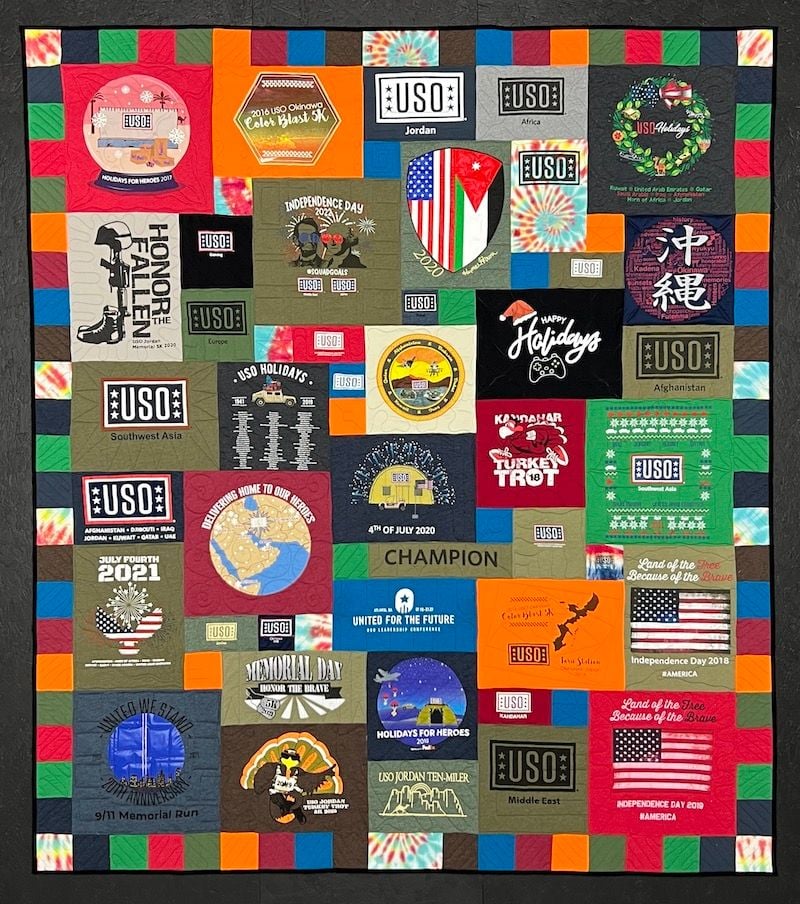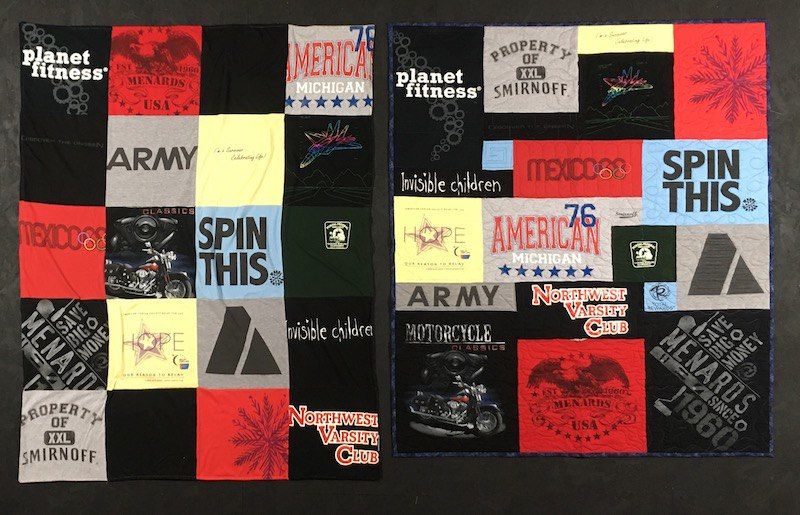8 Features of an Expensive T-shirt Quilt
- All the blocks are cut to fit the image on the T-shirt.
- The blocks are puzzled together.
- Sashing is not used.
- The quilt is actually a quilt and not a blanket.
- The quilt is long-arm machine quilted with a unique pattern for each block.
- A quilt is bound with a full binding.
- The backing material is 100% cotton.
- The batting is industry standard thickness and material.
4. The Quilt is Actually a Quilt and Not a Blanket
 First, a quilt and a blanket are not the same product! You can't compare a quilt to a blanket - they are just too different. You have to know the difference. Read more about the difference between a quilt and a blanket here.
First, a quilt and a blanket are not the same product! You can't compare a quilt to a blanket - they are just too different. You have to know the difference. Read more about the difference between a quilt and a blanket here.
A quilt has three layers held together with quilting. Whereas a blanket has two unconnected layers.
The additional cost of a quilt are a result of the following:
- Additional material for the batting and thread.
- The time to quilt a quilt.
- The machinery needed to do the quilting.
- The space for the machine - it's big.
A quilt will be more expensive than a blanket. And the difference between the two is huge. Here are two photos that can illustrate this better than I can write about it.
This first photo shows how the back is not connected to the front of a blanket.This second photo shows the back of this same blanket on the left. There is nothing - just the fabric. On the right in the photo is the back of one of our quilts. This is cool! Read more about quilting here.


5. The Quilt is Long-arm Machine Quilted With a Unique Pattern for Each Block
Expensive T-shirt quilts have a unique quilting pattern in for each block. Less expensive quilts have an over all quilting pattern. And even less expensive quilts are tied. Read more about the different quilting methods here.

The photo here shows two examples of quilting on the back of a T-shirt quilt. The quilt on the right is quilted in an over all pattern of loops. There is barely enough quilting to keep the batting from wadding up when the quilt is washed. The quilt on the left is a Too Cool T-shirt quilt. You can see how each block has its own design. This quilt has enough quilting to keep the batting in place. Read more about batting here.
The quilt on the right probably took 15 minutes or less to quilt. The quilt on the left took close to three hours to quilt. This adds up to a huge cost difference. It's a 1:12 time ratio. That is a lot of time!
6. The Quilt Is Bound With a Full Binding
 A binding is used to finish off the raw edges of a quilt. Expensive quilts use a full or true binding. This is a separate piece of fabric sewn around the entire quilt. This is the best type of binding for a quilt. It is also the most expensive.
A binding is used to finish off the raw edges of a quilt. Expensive quilts use a full or true binding. This is a separate piece of fabric sewn around the entire quilt. This is the best type of binding for a quilt. It is also the most expensive.
Less expensive quilts use a fold-over style binding. The backing material is simply folded over to the front of the quilt and sewn down. This is a lot less work than a full binding.
A blanket does not have a binding.
Our quilts are bound using a separate piece of material for a full binding. Here is a full explanation of the different binding styles.
7. The Backing Material is 100% Cotton
 Backing material should be made from 100% high quality cotton. Quality material is expensive. It cost even more if a quilter is not purchasing it wholesale. Many quilt maker will choose the least expensive material they can get away with. This helps keep their cost down and profits up. They bank on you not know the difference.
Backing material should be made from 100% high quality cotton. Quality material is expensive. It cost even more if a quilter is not purchasing it wholesale. Many quilt maker will choose the least expensive material they can get away with. This helps keep their cost down and profits up. They bank on you not know the difference.
Be careful when you are choosing a quilt maker. Ask if she is using high quality materials. You might ask to see the information from the end of the bolt of her fabric. In the photo here, you see the end of a bolt of our fabric. We use Robert Kaufman Kona cotton. This is the good stuff!
If the material is not 100% cotton, the quilt probably will cost less and be a lower quality. Read more about backing materials here.
8. The Batting is Industry Standard Thickness and Material
 Expensive T-shirt quilts use one of two types of industry standard batting. The first is 100% cotton. You might think this is the best. But 100% cotton tends to rip easily.
Expensive T-shirt quilts use one of two types of industry standard batting. The first is 100% cotton. You might think this is the best. But 100% cotton tends to rip easily.
We use batting that is 80% cotton/20% poly. It is needled punch. This means the batting is run through hot rollers with long needles. When the hot needles enter the batting, they melt the polyester. When they are pulled out, the melted polyester is pulled through the cotton fiber. When cool, the cotton fibers are held together by the melted polyester.
Cheaper quilts will be made with 100% polyester batting. This stuff is awful. But it's cheap. Note: the loft of batting has nothing to do with the quality of the batting. In the photo here, the good stuff is on the right.
Expensive T-shirt quilts use the good stuff. That's one reason they are more expensive! Read more about batting here.
Conclusion
There are times when the least expensive product makes sense to purchase. For example, when the item is exactly the same as the more expensive item. But there are times when cheap is crap, and you get what you pay for.
T-shirt quilts are like anything else. There are many different styles, options and quality levels.
Your reason for having a quilt made should line-up with the type and quality of quilt you purchase. If you want an heirloom quality quilt, it will cost more. If your budget dictates a less expensive quilt, you will need to lower your expectations.
"Anyone can make a T-shirt quilt, but very few can do it well."
Want to learn more about T-shirt quilts? Visit our Learning Center.
We have over 200 articles about all aspects of T-shirt quilts.




 8 Features That Make a T-shirt Quilt Expensive
8 Features That Make a T-shirt Quilt Expensive





 Sashing is fabric separating the rows and columns of a traditional style T-shirt quilt. Typically, sashing is 1 to 2 inches wide. Expensive T-shirt quilts are not made in a
Sashing is fabric separating the rows and columns of a traditional style T-shirt quilt. Typically, sashing is 1 to 2 inches wide. Expensive T-shirt quilts are not made in a 
